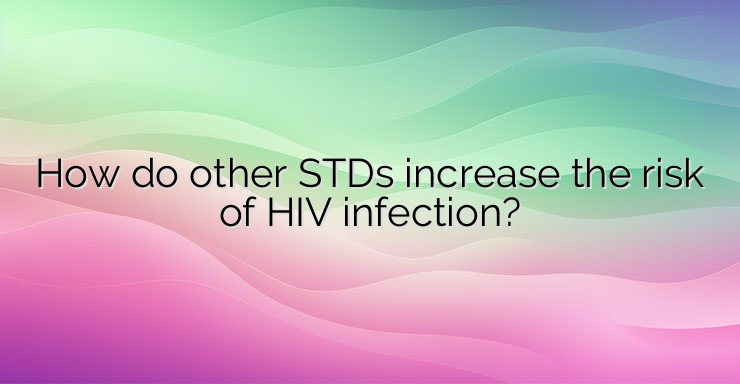Many sexually transmitted diseases are dangerous not only in themselves, but also because they can increase the risk of contracting other sexually transmitted infections, including HIV (human immunodeficiency virus) infection. HIV-positive individuals who are also infected with other sexually transmitted diseases are also more contagious. These individuals are three to five times more likely to transmit HIV to others during sexual intercourse. STDs increase the risk of contracting HIV in two ways. First, sexually transmitted infections can cause lesions on the skin (disruption of the integrity of the skin), which makes it easier for HIV to enter the body. Some sexually transmitted diseases that increase the risk of HIV in this way include: Syphilis – which causes a chancre (small painless sore or ulcer) on the skin or in the mouth; Chancroid – which can lead to painful sores in the genital area; Herpes – which causes clusters of blisters near the mouth or genitals Second, sexually transmitted infections can cause inflammation. Inflammation is initiated by the immune system. In the area of ??the body where there is inflammation, more immune cells accumulate. Because HIV has an affinity for infecting immune cells, any disease that causes these cells to increase also makes it easier for HIV to become infected. STDs that increase the risk of HIV in this way include: Gonorrhea; Chlamydia; Trichomoniasis Also, many sexually transmitted diseases increase the body’s susceptibility to HIV in both ways. Therefore, it is extremely important that any patient who has a sexually transmitted infection be treated as soon as possible. Practicing safe sex is extremely important in preventing STDs. Using condoms with every sexual activity significantly reduces the risk of contracting HIV. Regular examinations are also essential for the prevention of sexually transmitted diseases. Before a patient can be treated for a sexually transmitted infection, it must first be properly diagnosed. This is why regular screening is of utmost importance. Most sexually transmitted diseases are asymptomatic. This means that they do not cause complaints and infected persons may not know that they have an infection. In the absence of symptoms, the only way to ensure timely diagnosis of sexually transmitted diseases is screening. Otherwise, the infection can remain hidden for many years. That is why it is not enough to seek medical help only when symptoms are present. Every sexually active person should consider regular STD screening. Not only does this reduce the risk of HIV infection, but it also reduces the risk of STD-related infertility, a problem that does not only affect women. According to the data, in individuals who have a sexually transmitted disease,there is an increased risk of contracting other sexually transmitted diseases due to behavioral and social reasons. Generally, a person infected with a sexually transmitted disease is more likely to have unprotected sex. This is the biggest risk factor for contracting a sexually transmitted infection. Behavioral risk factors for infection also include: Unprotected sex outside of a monogamous relationship. Unprotected sex includes vaginal, oral and anal sex without a condom; Frequent and arbitrary change of sexual partners (promiscuity); Sex under the influence of alcohol or prohibited substances. Under these conditions, the taking of precautions or the adequate selection of a sexual partner may be hindered; Belonging to a community with a higher than average prevalence of sexually transmitted infections In the presence of an increased risk of HIV infection, pre-exposure prophylaxis or PrEP may be administered. People at high risk of HIV infection may take anti-HIV drugs to reduce the risk of contracting the virus. References: 1. Pines HA, Wertheim JO, Liu L, Garfein RS, Little SJ, Karris MY. Concurrency and HIV transmission network characteristics among MSM with recent HIV infection 2. Klein H. Anonymous sex and HIV risk practices among men using the Internet specifically to find male partners for unprotected sex 3. Hall HI, Holtgrave DR, Maulsby C. HIV transmission rates from persons living with HIV who are aware and unaware of their infection 4. Verywell Health. How Does STD Infection Increase HIV Risk?HIV transmission rates from persons living with HIV who are aware and unaware of their infection 4. Verywell Health. How Does STD Infection Increase HIV Risk?HIV transmission rates from persons living with HIV who are aware and unaware of their infection 4. Verywell Health. How Does STD Infection Increase HIV Risk?


Leave a Reply